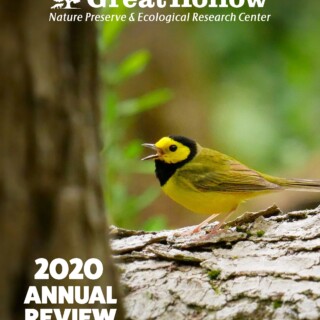
New Publication on the Impacts of Light Pollution to Bats
Light pollution is a rapidly spreading form of environmental degradation that now covers approximately 50% of the United States and 90% of Europe. It can have wide-ranging impacts to wildlife by causing changes in foraging behavior, space use, predator-prey interactions, communication, and reproduction. Now, new research published by Great Hollow in the journal Ecology and Evolution shows how disruptive light pollution can be to some of Connecticut’s bat species.
While the effects of light pollution on European bats have been well-studied in recent years, this topic has received far less attention in other parts of the world, including North America. To help address this knowledge gap, we conducted an experiment with a collaborator from Bat Conservation International, Dr. Amanda Adams, in which we illuminated airspace over Great Hollow’s wetland with LED floodlights during the summers of 2016 and 2017, and compared acoustic recordings of bats between nights when the lights were on and off. This allowed us to directly test the effects of artificial light at night on presence/absence, foraging activity, and species composition in a northeastern U.S. bat community, thus providing some of the first information about the sensitivity of these species to light pollution.
We observed substantial aversion to the lighting by the Big Brown Bat and endangered Little Brown Bat, while finding neutral or ambiguous effects on the three other species in the community (Eastern Red Bat, Hoary Bat, and Silver-haired Bat). This caused a significant shift in species composition in the presence of light, thereby disrupting natural competitive balance among species. The study species that exhibited the strongest aversion to the lighting, the Little Brown Bat, is also the one of greatest conservation concern. We detected Little Brown Bats over the wetland 65% of the time under natural conditions, but only 14% of the time and in significantly lower abundance when the lights were on. This is a clear indication that the Little Brown Bat is negatively impacted by light pollution, and may therefore experience restricted habitat availability and competitive disadvantages against other bats in light-polluted landscapes.
The results of our study show that only a small degree of lighting is a significant form of habitat degradation for some North American bats – one that will continue to spread in concert with human population growth and development across the continent, and increasingly challenge light-averse species to find dark habitats in which to live. This raises concerns about the impact that the abundance of artificial lighting in our towns, around our homes, and on our roads is having on bats, which provide ecologically and economically valuable services as insect predators. You can help bats by simply avoiding the use of any unnecessary outdoor lighting at your home at night. They will return the favor by keeping insect populations down on your property!
Journal reference: Seewagen, C.L. and A.M. Adams. 2021. Turning to the dark side: LED light at night alters the activity and species composition of a foraging bat assemblage in the northeastern United States. Ecology and Evolution [online early] doi.org/10.1002/ece3.7466
Photo by Christian Giese

 Previous Post
Previous Post Next Post
Next Post